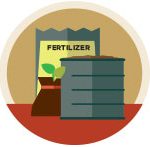4R Principles
4R Nutrient Stewardship principles include using the right nutrient source, at the right rate, at the right time, in the right place.
 When we talk about the right nutrient source, two key principles include ensuring a balanced supply of nutrients that suit soil properties. Nutrient sources can include commercial fertilizer, manure from livestock operations, compost, crop residues, and organic material from municipal wastewater treatment systems. Other principles include:
When we talk about the right nutrient source, two key principles include ensuring a balanced supply of nutrients that suit soil properties. Nutrient sources can include commercial fertilizer, manure from livestock operations, compost, crop residues, and organic material from municipal wastewater treatment systems. Other principles include:
- Supply nutrients in plant-available forms.
- Recognize synergisms & antagonism among nutrient elements and sources.
- Recognize blend compatability.
- Recognize benefits and sensitivities to associated elements.
- Control effects of non-nutritive elements.
 Principles that guide the right rate include assessing the nutrient supply from all sources and assessing plant demand. Examples of practices that support the right rate include testing soils for nutrients, calculating the economics, and balancing nutrients lost in crop removal. Other principles include:
Principles that guide the right rate include assessing the nutrient supply from all sources and assessing plant demand. Examples of practices that support the right rate include testing soils for nutrients, calculating the economics, and balancing nutrients lost in crop removal. Other principles include:
- Select a reasonable yield target.
- Assess soil nutrient supply and account for all available nutrient sources.
- Predict use efficiency of nutrient sources.
- Consider soil resource impacts.
- Consider rate-specific economics.
 The right timing assesses the dynamics of crop uptake and soil supply, to match nutrient availability as closely as possible to crop need. Decisions that support the right timing evaluate the risk of nutrient loss. Practices include pre-plant and at-planting nutrient applications and one or more sidedress applications. Timing is one of the most critical factors for Delmarva farmers to reduce nutrient losses. Other principles relating to right timing include:
The right timing assesses the dynamics of crop uptake and soil supply, to match nutrient availability as closely as possible to crop need. Decisions that support the right timing evaluate the risk of nutrient loss. Practices include pre-plant and at-planting nutrient applications and one or more sidedress applications. Timing is one of the most critical factors for Delmarva farmers to reduce nutrient losses. Other principles relating to right timing include:
- Recognize dynamics of crop management practices and soil nutrient loss.
- Evaluate logistics of field operations.
 The right place seeks to manage spatial variability and recognize crop rooting patterns. Options include broadcasting, banding, drilling, and injecting, as well as precision agriculture practices that incorporate variable-rate applications. Additional principles supporting the right placement of nutrients include:
The right place seeks to manage spatial variability and recognize crop rooting patterns. Options include broadcasting, banding, drilling, and injecting, as well as precision agriculture practices that incorporate variable-rate applications. Additional principles supporting the right placement of nutrients include:
- Consider soil chemical reactions.
- Suit the goals of the tillage system.
- Manage spatial variability.
(The information above is adapted from 4R Plant Nutrition.)
4R Plus looks at the whole system.
All of these principles are interrelated and must be considered together. 4R Plus is a whole system approach, incorporating practices that help to improve habitat, soil health and drainage management. 4R Plus systems may include:
- Adding biodiversity and continuing living roots to a system through crop rotations or cover crops, to feed soil microorganisms, cycle nutrients and improve water quality
- Reducing disturbance through low-till or no-till systems
- Support wildlife habitat through wetland restoration, buffers and other practices
- Integrated Pest Management (IPM) strategies, using cultural practices to reduce pest pressure, support beneficial insects and reduce the use and impact of pesticides
- Addressing nutrient losses at the edge-of-field by filtering drainage water that leaves a field through drainage tile or ditches, such as riparian and grass buffers, saturated buffers, gypsum curtains, denitrification (wood chip) buffers, and others
These and other farm management practices affect and are affected by the right source, rate, timing and placement of nutrients. Taking a 4R Plus approach helps to ensure a thriving agricultural legacy for future generations!